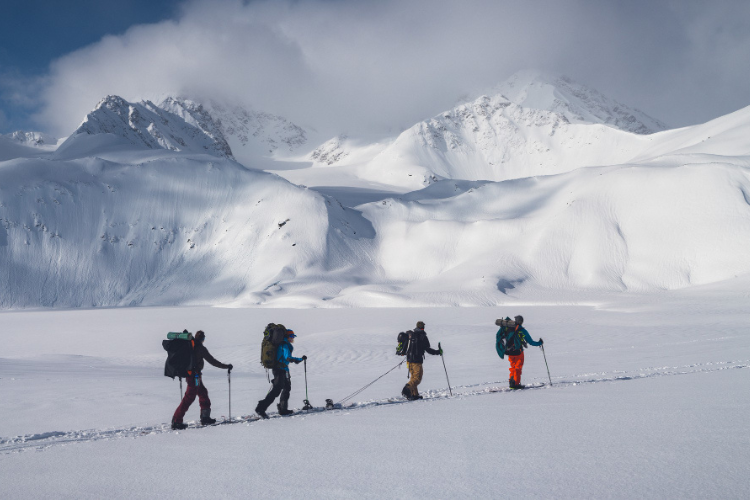Table Of Contents
Best Time For Everest Base Camp Trek: A Month-By-Month Guide
There’s a moment when you first glimpse Mount Everest on the trail—a mix of awe, effort, and altitude. But that magical moment? It depends heavily on when you go.
Then comes the most important time, when you have to choose the timing for the Everest Base Camp trek, which isn’t just about clear skies or blooming rhododendrons.
Many trekkers dive in without understanding how each season uniquely shapes the trek—and end up caught in poor weather, limited views, or logistical hurdles.
This guide will help you navigate Nepal’s trekking calendar month by month, breaking down weather, trail conditions, crowds, and visibility.
Whether you’re hoping to catch the sunrise over snow-draped peaks or avoid altitude sickness triggers, you’ll learn how to time your trek for the best possible experience.
We’ll also cover why some trekkers now choose an Everest Base Camp trek guide with a helicopter return, especially during certain seasons.
This can help you to save time and energy while still catching the full magic of the trail. Let’s help you choose the perfect window to make your Himalayan dream come true.
Why Timing Matters For The Everest Base Camp Trek
The Everest Base Camp trek isn’t just about getting there. It’s about when you go. Timing shapes your views, comfort, safety, and overall enjoyment.
Weather and altitude can drastically affect your experience. Cold temperatures, heavy snow, or rain can make the trail difficult or even dangerous. On the flip side, clear skies and stable weather enhance the breathtaking mountain vistas.
Many trekkers choose peak seasons without understanding the trade-offs. Crowds, high prices, or even altitude-related health issues can sneak up on the unprepared. This guide breaks down what each month offers so you can plan the perfect trek.
Everest Base Camp Trek In Spring (March To May)
I will add the spring season as the most popular time for trekking, under the everest base camp trek guide. The Everest Base Camp in spring is highly popular due to the favorable weather conditions and vibrant landscape.
March: Cold Mornings, Clear Days
March marks the end of winter. Mornings and nights are cold, but days are starting to warm up. Trails are less crowded compared to April. Snow still lingers at higher altitudes, adding a dramatic look to the landscape.
It’s a good month for trekkers who want quiet trails but decent visibility. Carry warm gear, especially for nights in Gorak Shep and Lobuche.
April: Peak Season Perfection
April is one of the best times for the Everest Base Camp trek. The weather is stable, visibility is great, and rhododendrons bloom along the lower trails.
Expect mild temperatures and busy tea houses. Book accommodation early. Helicopter flights also run more reliably in April due to clear skies.
May: Warmer And Quieter
May brings warmer days, making the trek more comfortable. However, clouds may start to appear in the afternoons, especially towards late May.
It’s less crowded than April, so it’s ideal if you prefer some solitude. You might spot Everest climbers in base camp preparing for their summit push.
Pros And Cons Of Trekking In Spring
Before you even start the planning, I think you must understand the advantages and disadvantages for your safety and a better experience.
| Pros | Cons |
| Stable weather, Clear mountain views, Blooming flora, Active mountaineering season | Popular trails can get crowded in April. Accommodation may be limited. UV exposure is strong |
Everest Base Camp In Autumn (September To November)
If you are ready to plan your trek during autumn, it would be an experience for you due to the pleasant weather conditions and stunning views. The clear sky, fresh air, and daytime temperature make it easier for you to have an amazing experience.
September: Transition From Monsoon
September marks the start of the autumn season. Early September may still bring residual monsoon showers, especially in the lower hills.
But by mid-September, skies begin to clear and the scenery is lush from recent rains. Be cautious of slippery trails.
October: The Most Popular Month
October is the best month for the Everest Base Camp trek for most people. The weather is dry, the skies are clear, and the temperatures are moderate.
Expect crowds, especially at Tengboche and Gorak Shep. Book ahead for tea houses and flights. Helicopter return is a great option this month to avoid the downhill rush.
November: Crisp Air, Fewer Trekkers
By November, the air gets colder, but skies often remain clear. Crowds start to thin out. It’s perfect for photographers and trekkers who want solitude without deep winter conditions.
Pack thermal layers. Night temperatures drop below freezing.
Autumn Trek Highlights And Challenges
Before you even start the planning, I think you must understand the advantages and disadvantages for your safety and a better experience.
| Pros | Cons |
| Best visibility. Comfortable day hiking temperatures. Dry trails. | Heavy foot traffic in October. Limited space in tea houses. Increasing cold in November |
Trekking To Everest Base Camp In Winter (December To February)
In this Everest Base Camp trek guide, we also have to mention winter. Well, trekking during winter is possible, ofcourse! However, it can be challenging due to cold and potential snowfall.
December: Quiet Trails And Clear Views
December offers crisp skies and peaceful trails. The cold is manageable in early December, especially at lower elevations. Stunning views and lower prices. Be prepared for occasional snow blockages near base camp.
January And February
Coldest months on the trail. Temperatures at Gorak Shep can drop below -20°C. Snow can block passes.
If you trek in these months, expect basic conditions, fewer open tea houses, and shorter days.
Who Should Go In Winter?
If you like solitude and have good winter gear, this season offers silence and beauty. Experienced trekkers and those who want a real challenge might like it.
Keyword tip: Use variations like “Everest Base Camp in winter”, “trekking EBC in December”, and “quiet time for Everest trek”.
Is Monsoon Worth It?
While talking about the Everest Base Camp trek guide, we have to mention the monsoon season. We often romanticize monsoons in the mountains or hilly areas. However, it may not be the case when it comes to the Everest trek.
So, is monsoon worth it? Let’s find out!
Rain, Clouds, And Mud
Monsoon brings heavy rain, leeches, and cloud cover. Landslides on the road to Lukla and even lower trails.
Most days start with fog and drizzle. Afternoon storms are common. Everest is not visible.
Green Landscapes And Fewer People
One good thing? Everything is green and alive. Farmers work in terraced fields. Waterfalls cascade down the hillsides.
The region is quiet. Very few trekkers venture out. Helicopter returns may be delayed or cancelled due to bad weather.
Risks Vs Rewards
Unless you’re an off-season adventurer, monsoon isn’t ideal. The risk of delayed flights, slippery trails, and limited views makes it less popular.
Still, it can be magical if you get good weather windows and like the monsoon atmosphere.
When Is The Best Time For EBC Trek?
I get it! At this moment, you may be confused between Spring vs Autumn. Let me help you understand which one can be suitable for you!
Spring and autumn are both good for the EBC trek. Spring has flowers and Everest climbers. Autumn has clear skies.
Choose spring if you like forests and don’t mind some cloud cover. Choose autumn if you want the best mountain views and dry weather.
What should be your top priorities?
- Views: October and November
- Fewer people: March, May, or late November
- Mild weather: April and October
- Budget: December or June
Here’s a Month-by-Month Breakdown
| Month | Weather | Crowds | Best For |
| March | Cold, clear | Low | Quiet trails, snow views |
| April | Mild, clear | High | Flowers, stable weather |
| May | Warmer, cloudy | Medium | Fewer crowds, mountaineers |
| June-August | Rainy, cloudy | Low | Greenery, monsoon atmosphere |
| September | Wet to dry | Medium | Fresh landscapes, transitioning |
| October | Dry, clear | Very High | Best overall conditions |
| November | Cold, clear | Medium | Photography, clear skies |
| December | Cold, dry | Low | Peaceful, off-season deals |
| Jan-Feb | Freezing, clear | Very Low | Hardcore adventurers |
When To Do The EBC Trek With Helicopter Return
So, what are the best months for helicopter return? Spring and autumn are best for the Everest Base Camp trek with Helicopter return. Clear skies mean more reliable flights. April and October are ideal.
Avoid the monsoon season unless you like potential delays. Winter flights may get cancelled due to snow or fog.
The question that comes to mind is: how does the weather affect helicopter flights? Well, helicopter operations rely on visibility and wind.
In bad weather, flights are grounded for safety. That’s why pre-booking is risky during unpredictable months.
Morning flights are generally more reliable. Keep your itinerary flexible to adjust for changes.
Now, who should do this?
- Trekkers short on time
- Those who want to skip the long descent
- Anyone who wants a scenic aerial view of the Himalayas
Helicopter return also reduces the risk of knee injuries and altitude fatigue on the way down. It’s especially useful for trekkers not used to multi-day downhill hiking.
Everest Base Camp Trekking Season FAQs
October is unbeatable for clear skies and crisp views. November is a close second.
March, May, and late November offer good conditions and fewer trekkers.
April and October are peak seasons, so flights and tea houses are more expensive. Book early.
It depends on your preparation. Monsoon has landslide risks. Winter demands proper cold-weather gear and stamina.
Spring and autumn, especially mornings in April, October, and November. Avoid afternoon flights during the monsoon.
Everest Base Camp Trek Guide: Big Trekking Companies Vs The Small Ones
While large trekking companies can offer you a wide range of options. They can even potentially lower prices due to economies of scale. However, they might not be the best fit for every single trekker.
Here’s why:
- The large companies often focus on high volume and a very standardized itinerary. So, if you prefer a personalized trek, it can be difficult for you!
- There are also fewer chances for customization in the trekking itinerary, such as the Everest Base Camp trek guide.
- While in the presence of competitive pricing and profit margins, some of the large companies often engage in compromising quality and ethics.
Small trekking companies, on the other hand, can offer you a more reliable and satisfying experience for various reasons.
- The small companies often focus on building personal relationships with the clients. Thus, they prefer taking all sorts of input and preferences for better customization.
- Many small trekking businesses also hire people from the locality itself. This makes a huge change in your overall trekking experience.
- While working with the small trekking businesses, you also get the right support from the community and economy.
- Moreover, they also ensure that quality and safety for the clients to make your trekking mor enjoyable.
Conclusion: Choose Your Best Time For EBC Based On Your Priorities
There’s no one-size-fits-all answer. The best time for the EBC trek depends on what you value most. Want views and don’t mind crowds? October. Peace and cold? March or November. Flowers and spring? April.
Short on time or want to skip the long descent? Do the EBC trek with a helicopter return. Adventure and comfort combined with aerial views.
Pack smart, plan, and choose your month. With the right timing, your EBC trek will be forever memorable.
Read More:














